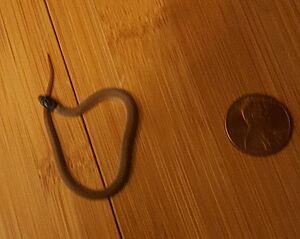Southwestern blackhead snake facts for kids
Quick facts for kids Southwestern blackhead snake |
|
|---|---|
 |
|
| Conservation status | |
| Scientific classification | |
| Genus: |
Tantilla
|
| Species: |
hobartsmithi
|
| Synonyms | |
|
|
The southwestern blackhead snake (scientific name: Tantilla hobartsmithi) is a small snake. It belongs to a group of snakes called colubrids. You can find this snake in the southwestern United States and northern Mexico.
Contents
What's in a Name?
The second part of the snake's scientific name, hobartsmithi, honors an American zoologist and herpetologist named Hobart M. Smith (1912–2013). A herpetologist is a scientist who studies reptiles and amphibians.
What Does It Look Like?
The southwestern blackhead snake is quite small. It can grow up to 15 in (38 cm) long, including its tail. However, most of these snakes are usually around 8 in (20 cm) long.
Its back is plain brown. Its head is black, which is why it's called the "blackhead snake"! It also has a cream or white band around its neck. If you look at its belly, you'll see a wide reddish stripe running down the middle.
Is It Venomous?
This snake has special teeth at the back of its mouth. It also has a special kind of spit (saliva). This spit is not harmful to people or other mammals. Scientists believe it is only toxic to arthropods, which are the insects and centipedes it eats.
How Does It Behave?
Blackhead snakes, like the southwestern blackhead snake, are mostly nocturnal. This means they are active at night. They are also fossorial, which means they spend most of their time underground. You can find them hiding in loose soil, under leaves, or beneath other things on the ground.
What Does It Eat?
Blackhead snakes enjoy eating soft-bodied insects. They also like to munch on centipedes.
Reproduction
The southwestern blackhead snake is oviparous. This means the female snake lays eggs.
Where Does It Live?
You can find the southwestern blackhead snake in several states in the southwestern United States. These include Arizona, California, Colorado, Nevada, New Mexico, Texas, and Utah. It also lives in northern Mexico, in areas like Chihuahua, Coahuila, and Sonora.
What Kind of Places Does It Like?
This snake prefers to live in natural habitats such as deserts, grasslands, shrublands, and forests.


